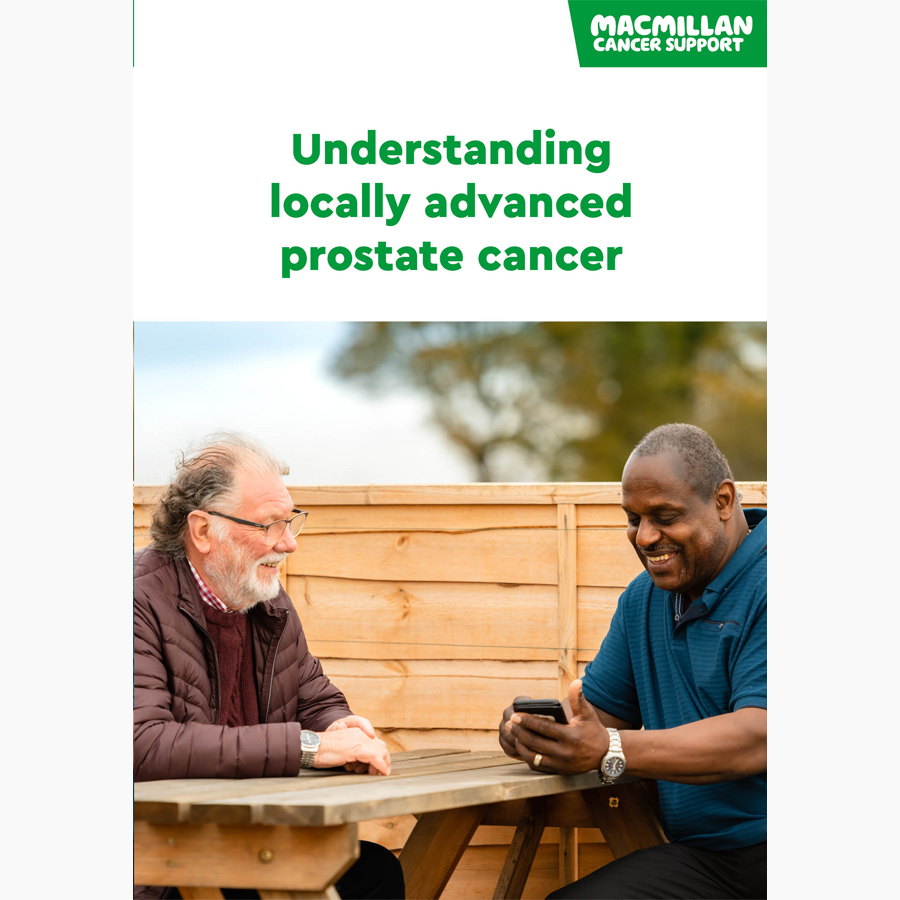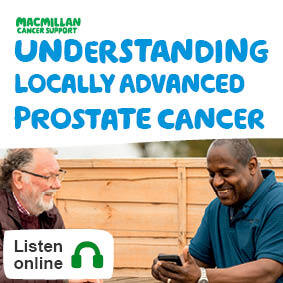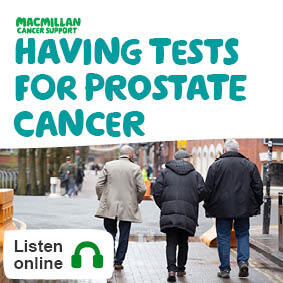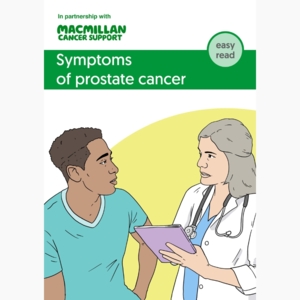Locally advanced prostate cancer
Choose a type
On this page
-
What is locally advanced prostate cancer?
-
Symptoms of locally advanced prostate cancer
-
Causes of locally advanced prostate cancer
-
Diagnosis of locally advanced prostate cancer
-
Staging and grading of locally advanced prostate cancer
-
Treatment for locally advanced prostate cancer
-
After locally advanced prostate cancer treatment
-
About our information
-
How we can help
What is locally advanced prostate cancer?
Consultant urologist, Jonathan Aning, talks you through what prostate cancer is, the main types, risk factors, stages and common treatments available to you.
Locally advanced prostate cancer is when the cancer has grown through the capsule that surrounds the prostate. It may have started to spread into tissue or organs close by. The results of your tests help tell your doctor the stage of the cancer and if it is locally advanced.
Related pages
Booklets and resources
Symptoms of locally advanced prostate cancer
Prostate cancer symptoms only happen when the cancer is large enough to press on the tube that carries the urine from the bladder (urethra). Some prostate cancers grow very slowly. Symptoms may not develop for many years.
The prostate can also become enlarged due to a non-cancerous condition called benign prostatic hyperplasia (BPH).
The symptoms of benign (non-cancerous) prostate conditions and prostate cancer are similar. They can include:
- needing to pee more often than usual, especially at night
- difficulty peeing – for example, a weak flow or having to strain to start peeing
- feeling like you have not completely emptied your bladder
- an urgent need to pee
- blood in urine or semen
- rarely, pain when peeing or ejaculating.
If you have any of these symptoms, it is important to have them checked by your doctor. Your GP can do some tests to find out if you need a referral to a specialist doctor.
If prostate cancer spreads, it usually goes to the bones. It may cause pain in the bones, such as in the back. This is called advanced prostate cancer.
Related pages
Causes of locally advanced prostate cancer
Certain things called risk factors may increase the risk of developing prostate cancer. If you are Black, you have a much higher risk of developing prostate cancer. You are also more likely to develop it at a younger age. Having a strong family history of prostate cancer is also a risk factor.
We have more information about the risk factors of prostate cancer.
Diagnosis of locally advanced prostate cancer
You usually start by seeing your GP to have your symptoms checked. Your GP usually arranges some tests. The first tests used to diagnose prostate cancer are:
-
Rectal Examination
The doctor gently inserts a gloved finger (using lubricating gel) into your back passage (rectum). The rectum is close to the prostate gland so your doctor can feel for anything unusual in the prostate. A rectal examination test is quick and it should not be painful. It is also sometimes called Digital Rectal Examination (DRE).
-
PSA test
The PSA test is a blood test to measure the level of prostate-specific antigen (PSA) in your blood. Prostate cancer often causes a raised level of PSA. But different things such as non-cancerous prostate conditions and getting older can also increase your PSA.
If your PSA level is raised or your rectal examination is unusual your GP refers you to a specialist doctor (urologist). Your GP may test your PSA level again if it is raised but your prostate feels normal.
At the hospital
A specialist doctor or nurse asks about your symptoms and any other medical conditions. They check if you have any risk factors for prostate cancer. The doctor may do another rectal examination and arrange another PSA test. They will talk to you about further tests you may have. These may include:
-
A multi-parametric MRI scan
You may have this specialised scan to help your doctor decide if you need to have a prostate biopsy. A multi-parametric MRI scan gives a more detailed picture of the prostate gland and surrounding area than a standard MRI scan.
-
Trans-rectal ultrasound (TRUS) biopsy
You may have a TRUS biopsy if tests show you may have prostate cancer. They use a fine needle to remove samples of prostate tissue to examine for cancer cells. This is done through an ultrasound probe your doctor passes into your back passage. You have an injection of local anaesthetic to numb the area first.
-
Trans-Perineal (TP) biopsy
You may have a Trans-Perineal biopsy instead of a TRUS biopsy. The doctor takes samples of the prostate gland through the area between the scrotum and the back passage (called the perineum). It can be done under a general anaesthetic or using local anaesthetic to numb the area first.
Further tests after diagnosis
Whether you have any further tests will depend on the risk of the cancer growing quickly. Doctors work out your risk by looking at the PSA level, the stage, and the grade of the cancer.
To help diagnose or stage prostate cancer, you may have staging tests:
- an MRI (magnetic resonance imaging) scan
- a bone scan
- a CT scan
- more blood tests.
Booklets and resources
Staging and grading of locally advanced prostate cancer
Knowing the stage, grade and risk group of the cancer helps you and your doctor to decide on the best treatment for you.
The stage
The stage of prostate cancer describes its size and how far it has spread, based on your test results. Doctors often use the TNM staging system or a number staging system.
The grade
Your doctor decides the grade by how the prostate cancer cells (from your biopsy) look under the microscope. This tells them how quickly the cancer might grow or spread. Doctors use a combination of 2 systems to grade prostate cancer:
- Gleason score - examines the pattern of cells in the prostate tissues and grades them from 1 to 5. The most common and highest grades are added to give your Gleason score
- Grade Group - grades the cancer between 1 and 5 based on your Gleason score.
Risk group
Prostate cancer is also divided into risk groups. Your treatment options will depend on the risk group the cancer is in.
Your doctor looks at the stage of the cancer, your PSA level and your Gleason score to work out the risk group. They use a system called the Cambridge Prognostic Group (CPG). It divides prostate cancer risk into 5 different groups.
Treatment for locally advanced prostate cancer
A team of specialists meet to discuss the best possible treatment for you. This is called a multidisciplinary team (MDT).
Treatment may cure locally advanced prostate cancer or keep it under control for many years. There are different treatments. Your treatment will depend on:
- your general health
- your age
- the Gleason score and cancer grade
- the stage of the cancer
- the risk group of the cancer
- your preferences.
Your doctor and nurse will talk to you about the different things to think about when making treatment decisions. Treatment side effects can include erection difficulties (ED), urinary or bowel problems. They will explain the different benefits and disadvantages of each treatment. You and your doctor can then decide on the best treatment for you.
The main treatments for locally advanced prostate cancer are:
-
Radiotherapy
Radiotherapy uses high-energy x-rays to destroy the cancer cells. External beam radiotherapy (given from outside the body) is often the main treatment for locally advanced prostate cancer. You may have some internal radiotherapy called brachytherapy along with it.
-
Hormonal therapy
Prostate cancer needs the hormone testosterone to grow. Hormonal therapies reduce the amount of testosterone in the body. You may have hormonal therapy as tablets or injections. It may be given for several months or up to 3 years after radiotherapy to make your treatment more effective. Hormonal therapy is sometimes given on its own.
-
Watchful waiting
During watchful waiting, you see your doctor regularly to check on (monitor) the cancer. If you have symptoms or there are signs the cancer is growing you can have treatment, usually with hormonal therapy.
The following treatments are less commonly used in locally advanced prostate cancer:
- Surgery or radical prostatectomy
An operation to remove the prostate (prostatectomy) is not often done in locally advanced prostate cancer. It may not be possible to remove all the cancer cells that have spread. You usually have radiotherapy afterwards.
An operation called a transurethral resection of the prostate (TURP) may be done before radiotherapy to help with problems passing urine. - Chemotherapy
Chemotherapy uses anti-cancer (cytotoxic) drugs to destroy cancer cells. You may have chemotherapy if there is a higher risk of locally advanced prostate cancer coming back.
You may also have some treatments as part of a clinical trial.
Find out more about prostate cancer treatments.
After locally advanced prostate cancer treatment
You will have regular follow-up appointments after treatment for prostate cancer.
You may get anxious between appointments. This is natural. It may help to get support from family, friends or a support organisation such as Prostate Cancer UK.
Macmillan is also here to support you. If you would like to talk, you can:
- Call the Macmillan Support Line on 0808 808 00 00.
- Chat online to our specialists online.
- Visit our prostate cancer forum to talk with people who have been affected by prostate cancer, share your experience, and ask an expert your questions.
Sex, relationships and fertility
Prostate cancer treatments can affect your sex life. They can reduce your sex drive (libido) and cause difficulties getting an erection. This is called erectile dysfunction or ED. This may be very worrying for you. There are different treatments and support available to improve sexual difficulties.
Talk to your doctor or nurse about sexual difficulties or concerns. They will be used to talking about these issues. You may want to involve a partner in these discussions.
Fertility
Prostate cancer treatments can affect your fertility. If this is a concern for you, talk to your doctor or nurse. You may be able to store sperm before treatment starts.
Well-being and recovery
Even if you already have a healthy lifestyle, you may choose to make some positive lifestyle changes after treatment.
Small changes to the way you live such as eating well and keeping active can improve your health and well-being and help your body recover.
About our information
-
References
Below is a sample of the sources used in our prostate cancer information. If you would like more information about the sources we use, please contact us at cancerinformationteam@macmillan.org.uk
C. Parker, E. Castro, K. Fizazi, et al. Prostate cancer: ESMO Clinical Practice Guidelines for diagnosis, treatment and follow-up. Annals of Oncology, 2020, Volume 31, Issue 9, p1119-1134. Available from www.esmo.org/guidelines/genitourinary-cancers/prostate-cancer
National Institute for Health and Care Excellence (2019) Prostate cancer: diagnosis and management (NICE guideline NG131). Last updated December 2021 to include Risk stratification for localised or locally advanced prostate cancer. Available at www.nice.org.uk/guidance/ng131
-
Reviewers
This information has been written, revised and edited by Macmillan Cancer Support’s Cancer Information Development team. It has been reviewed by expert medical and health professionals and people living with cancer. It has been approved by Senior Medical Editors, Dr Jim Barber, Consultant Clinical Oncologist and Dr Ursula McGovern, Consultant Medical Oncologist.
Our cancer information has been awarded the PIF TICK. Created by the Patient Information Forum, this quality mark shows we meet PIF’s 10 criteria for trustworthy health information.
The language we use
We want everyone affected by cancer to feel our information is written for them.
We want our information to be as clear as possible. To do this, we try to:
- use plain English
- explain medical words
- use short sentences
- use illustrations to explain text
- structure the information clearly
- make sure important points are clear.
We use gender-inclusive language and talk to our readers as ‘you’ so that everyone feels included. Where clinically necessary we use the terms ‘men’ and ‘women’ or ‘male’ and ‘female’. For example, we do so when talking about parts of the body or mentioning statistics or research about who is affected.
You can read more about how we produce our information here.
Date reviewed
This content is currently being reviewed. New information will be coming soon.

Our cancer information meets the PIF TICK quality mark.
This means it is easy to use, up-to-date and based on the latest evidence. Learn more about how we produce our information.
How we can help








